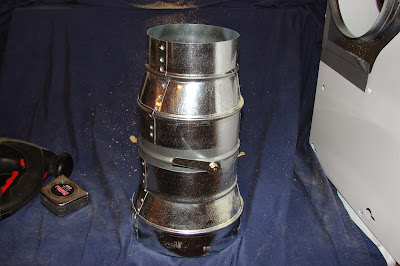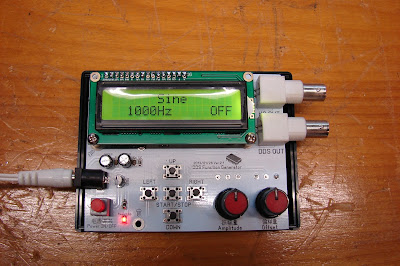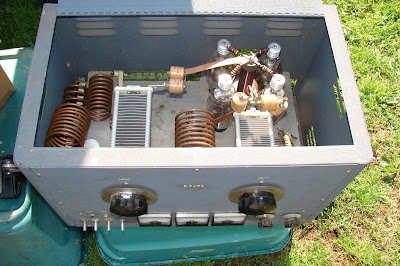This Arduino powered 5 Million samples per second oscilloscope uses an external CA3306 analog to digital converter. the Ca3306 produces less glitches than the AD775 did. Here is the video on YouTube.
http://youtu.be/f_RD1oQuKiw I fixed the memory issue and even sped it up some more by changing the array from 320 integers to 240 bytes. Integers are 16 bits long and bytes are 8 bits long, so it is much faster and uses less memory.
I also added a trigger and speed selection switch on D12 and D13 to ground. The speed selection has 10 modes. They range from no loop, to a loop with no delay, to eight available delay settings.
Here is a picture of the screen of the oscilloscope running in its fastest mode.
Here is a picture of the CA3306 wiring, it is much easier than the other Analog to digital converter was.
Here is the CA3306 schematic diagram;
Here is a oscilloscope like input section schematic. I used two 9 volt batteries to test it out. It give the ability to handle inputs of up to 50 volts and also allows gain selection. It is a much simpler design than the input section that was in my book "Digital and Computer projects".
Here is the code. It uses two push buttons, one on D12 and one on D13 to select the sample rate and the trigger level. To be honest the trigger does not work very well yet.
//****************************************
// Three color 5msps ext AtoD Scope
// By Bob Davis
// UTFT_(C)2012 Henning Karlsen
// web: http://www.henningkarlsen.com/electronics
//
// Switches on D12 & D13 determine sweep speed and trigger level
//*******************************************
#include
// Declare which fonts we will be using
extern uint8_t SmallFont[];
extern uint8_t BigFont[];
extern uint8_t SevenSegNumFont[];
// Note that the control pins are now assigned to 8-11
UTFT myGLCD(ILI9325C,8,9,10,11);
int Input=0;
byte Sample[320];
byte OldSample[320];
int StartSample=0;
int EndSample=0;
int MaxSample=0;
int MinSample=0;
int mode=0;
int dTime=1;
int Trigger=10;
int SampleSize=0;
int SampleTime=0;
void DrawMarkers(){
myGLCD.setColor(0, 220, 0);
myGLCD.drawLine(0, 0, 0, 240);
myGLCD.drawLine(60, 0, 60, 240);
myGLCD.drawLine(120, 0, 120, 240);
myGLCD.drawLine(180, 0, 180, 240);
myGLCD.drawLine(239, 0, 239, 240);
myGLCD.drawLine(319, 0, 319, 240);
myGLCD.drawLine(0, 0, 319, 0);
myGLCD.drawLine(0, 60, 319, 60);
myGLCD.drawLine(0, 120, 319, 120);
myGLCD.drawLine(0, 180, 319, 180);
myGLCD.drawLine(0, 239, 319, 239);
}
void setup() {
myGLCD.InitLCD();
myGLCD.clrScr();
pinMode(12, INPUT);
digitalWrite(12, HIGH);
pinMode(13, INPUT);
digitalWrite(13, HIGH);
pinMode(14, INPUT);
pinMode(15, INPUT);
pinMode(16, INPUT);
pinMode(17, INPUT);
pinMode(18, INPUT);
pinMode(19, INPUT);
}
void loop() {
// Set the background color(Red, Green, Blue)
myGLCD.setBackColor(0, 0, 0);
myGLCD.setFont(BigFont);
char buf[12];
while(1) {
DrawMarkers();
if (digitalRead(13) == 0) mode++;
if (mode > 10) mode=0;
// Select delay times for scan modes
if (mode == 0) dTime=0;
if (mode == 1) dTime=0;
if (mode == 2) dTime=1;
if (mode == 3) dTime=2;
if (mode == 4) dTime=5;
if (mode == 5) dTime=10;
if (mode == 6) dTime=20;
if (mode == 7) dTime=50;
if (mode == 8) dTime=100;
if (mode == 9) dTime=200;
if (mode == 10) dTime=500;
// Select trigger level
if (digitalRead(12) == 0) Trigger=Trigger+10;
if (Trigger > 50) Trigger=0;
// Wait for input to be greater than trigger
while (Input < Trigger){
Input = PINC;
}
// Collect the analog data into an array
if (mode == 0) {
// Read analog port as a parallel port no loop
StartSample = micros();
Sample[0]=PINC;
Sample[1]=PINC; Sample[2]=PINC; Sample[3]=PINC;
Sample[4]=PINC; Sample[5]=PINC; Sample[6]=PINC;
Sample[7]=PINC; Sample[8]=PINC; Sample[9]=PINC;
Sample[10]=PINC; Sample[11]=PINC; Sample[12]=PINC;
Sample[13]=PINC; Sample[14]=PINC; Sample[15]=PINC;
Sample[16]=PINC; Sample[17]=PINC; Sample[18]=PINC;
Sample[19]=PINC; Sample[20]=PINC; Sample[21]=PINC;
Sample[22]=PINC; Sample[23]=PINC; Sample[24]=PINC;
Sample[25]=PINC; Sample[26]=PINC; Sample[27]=PINC;
Sample[28]=PINC; Sample[29]=PINC; Sample[30]=PINC;
Sample[31]=PINC; Sample[32]=PINC; Sample[33]=PINC;
Sample[34]=PINC; Sample[35]=PINC; Sample[36]=PINC;
Sample[37]=PINC; Sample[38]=PINC; Sample[39]=PINC;
Sample[40]=PINC; Sample[41]=PINC; Sample[42]=PINC;
Sample[43]=PINC; Sample[44]=PINC; Sample[45]=PINC;
Sample[46]=PINC; Sample[47]=PINC; Sample[48]=PINC;
Sample[49]=PINC; Sample[50]=PINC; Sample[51]=PINC;
Sample[52]=PINC; Sample[53]=PINC; Sample[54]=PINC;
Sample[55]=PINC; Sample[56]=PINC; Sample[57]=PINC;
Sample[58]=PINC; Sample[59]=PINC; Sample[60]=PINC;
Sample[61]=PINC; Sample[62]=PINC; Sample[63]=PINC;
Sample[64]=PINC; Sample[65]=PINC; Sample[66]=PINC;
Sample[67]=PINC; Sample[68]=PINC; Sample[69]=PINC;
Sample[70]=PINC; Sample[71]=PINC; Sample[72]=PINC;
Sample[73]=PINC; Sample[74]=PINC; Sample[75]=PINC;
Sample[76]=PINC; Sample[77]=PINC; Sample[78]=PINC;
Sample[79]=PINC; Sample[80]=PINC; Sample[81]=PINC;
Sample[82]=PINC; Sample[83]=PINC; Sample[84]=PINC;
Sample[85]=PINC; Sample[86]=PINC; Sample[87]=PINC;
Sample[88]=PINC; Sample[89]=PINC; Sample[90]=PINC;
Sample[91]=PINC; Sample[92]=PINC; Sample[93]=PINC;
Sample[94]=PINC; Sample[95]=PINC; Sample[96]=PINC;
Sample[97]=PINC; Sample[98]=PINC; Sample[99]=PINC;
Sample[100]=PINC; Sample[101]=PINC; Sample[102]=PINC;
Sample[103]=PINC; Sample[104]=PINC; Sample[105]=PINC;
Sample[106]=PINC; Sample[107]=PINC; Sample[108]=PINC;
Sample[109]=PINC; Sample[110]=PINC; Sample[111]=PINC;
Sample[112]=PINC; Sample[113]=PINC; Sample[114]=PINC;
Sample[115]=PINC; Sample[116]=PINC; Sample[117]=PINC;
Sample[118]=PINC; Sample[119]=PINC; Sample[120]=PINC;
Sample[121]=PINC; Sample[122]=PINC; Sample[123]=PINC;
Sample[124]=PINC; Sample[125]=PINC; Sample[126]=PINC;
Sample[127]=PINC; Sample[128]=PINC; Sample[129]=PINC;
Sample[130]=PINC; Sample[131]=PINC; Sample[132]=PINC;
Sample[133]=PINC; Sample[134]=PINC; Sample[135]=PINC;
Sample[136]=PINC; Sample[137]=PINC; Sample[138]=PINC;
Sample[139]=PINC; Sample[140]=PINC; Sample[141]=PINC;
Sample[142]=PINC; Sample[143]=PINC; Sample[144]=PINC;
Sample[145]=PINC; Sample[146]=PINC; Sample[147]=PINC;
Sample[148]=PINC; Sample[149]=PINC; Sample[150]=PINC;
Sample[151]=PINC; Sample[152]=PINC; Sample[153]=PINC;
Sample[154]=PINC; Sample[155]=PINC; Sample[156]=PINC;
Sample[157]=PINC; Sample[158]=PINC; Sample[159]=PINC;
Sample[160]=PINC; Sample[161]=PINC; Sample[162]=PINC;
Sample[163]=PINC; Sample[164]=PINC; Sample[165]=PINC;
Sample[166]=PINC; Sample[167]=PINC; Sample[168]=PINC;
Sample[169]=PINC; Sample[170]=PINC; Sample[171]=PINC;
Sample[172]=PINC; Sample[173]=PINC; Sample[174]=PINC;
Sample[175]=PINC; Sample[176]=PINC; Sample[177]=PINC;
Sample[178]=PINC; Sample[179]=PINC; Sample[180]=PINC;
Sample[181]=PINC; Sample[182]=PINC; Sample[183]=PINC;
Sample[184]=PINC; Sample[185]=PINC; Sample[186]=PINC;
Sample[187]=PINC; Sample[188]=PINC; Sample[189]=PINC;
Sample[190]=PINC; Sample[191]=PINC; Sample[192]=PINC;
Sample[193]=PINC; Sample[194]=PINC; Sample[195]=PINC;
Sample[196]=PINC; Sample[197]=PINC; Sample[198]=PINC;
Sample[199]=PINC; Sample[200]=PINC; Sample[201]=PINC;
Sample[202]=PINC; Sample[203]=PINC; Sample[204]=PINC;
Sample[205]=PINC; Sample[206]=PINC; Sample[207]=PINC;
Sample[208]=PINC; Sample[209]=PINC; Sample[210]=PINC;
Sample[211]=PINC; Sample[212]=PINC; Sample[213]=PINC;
Sample[214]=PINC; Sample[215]=PINC; Sample[216]=PINC;
Sample[217]=PINC; Sample[218]=PINC; Sample[219]=PINC;
Sample[220]=PINC; Sample[221]=PINC; Sample[222]=PINC;
Sample[223]=PINC; Sample[224]=PINC; Sample[225]=PINC;
Sample[226]=PINC; Sample[227]=PINC; Sample[228]=PINC;
Sample[229]=PINC; Sample[230]=PINC; Sample[231]=PINC;
Sample[232]=PINC; Sample[233]=PINC; Sample[234]=PINC;
Sample[235]=PINC; Sample[236]=PINC; Sample[237]=PINC;
Sample[238]=PINC; Sample[239]=PINC; Sample[240]=PINC;
EndSample = micros();
}
if (mode == 1) {
// Read analog port as a parallel port no delay
StartSample = micros();
for(int xpos=0; xpos<240; xpos++) {
Sample[xpos]=PINC;
}
EndSample = micros();
}
if (mode >= 2) {
// Read analog port as a parallel port variable delay
StartSample = micros();
for(int xpos=0; xpos<240; xpos++) {
Sample[xpos]=PINC;
delayMicroseconds(dTime);
}
EndSample = micros();
}
// Display the collected analog data from array
for(int xpos=0; xpos<239; xpos++) {
// Erase the old stuff
myGLCD.setColor(0, 0, 0);
myGLCD.drawLine (xpos+1, 255-OldSample[xpos+1]*4, xpos+2, 255-OldSample[xpos+2]*4);
if (xpos==0) myGLCD.drawLine (xpos+1, 1, xpos+1, 239);
// Draw the new data
myGLCD.setColor(255, 255, 255);
myGLCD.drawLine (xpos, 255-Sample[xpos]*4, xpos+1, 255-Sample[xpos+1]*4);
}
// Determine sample voltage peak to peak
MaxSample = Sample[100];
MinSample = Sample[100];
for(int xpos=0; xpos<240; xpos++) {
OldSample[xpos] = Sample[xpos];
if (Sample[xpos] > MaxSample) MaxSample=Sample[xpos];
if (Sample[xpos] < MinSample) MinSample=Sample[xpos];
}
// display the sample time, delay time and trigger level
myGLCD.setColor(0, 0, 255);
SampleTime=EndSample-StartSample;
myGLCD.print("uSec.", 240, 10);
myGLCD.print(" ", 240, 30);
myGLCD.print(itoa(SampleTime, buf, 10), 240, 30);
myGLCD.print("Delay", 240, 70);
myGLCD.print(" ", 240, 90);
myGLCD.print(itoa(dTime, buf, 10), 240, 90);
myGLCD.print("Trig.", 240, 130);
myGLCD.print(itoa(Trigger, buf, 10), 240, 150);
// Range of 0 to 64 * 78 = 4992 mV
SampleSize=(MaxSample-MinSample)*78;
myGLCD.print("mVolt", 240, 190);
myGLCD.print(itoa(SampleSize, buf, 10), 240, 210);
}
}

















































